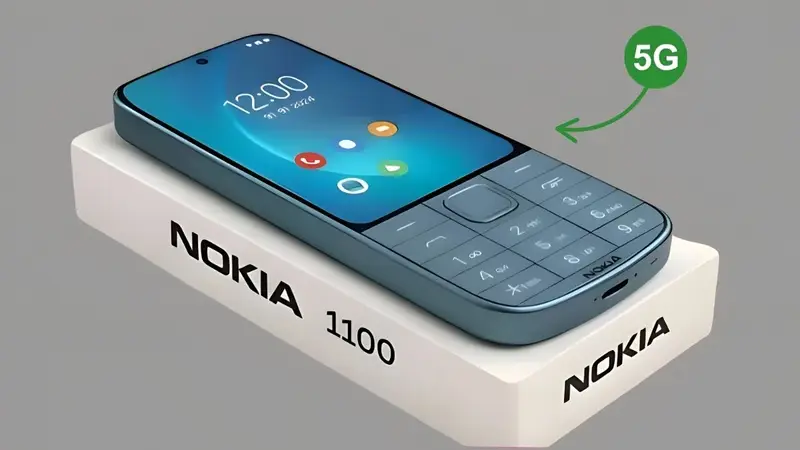The Nokia 1100, launched in 2003, was Nokia’s ultra-basic GSM candybar phone that became the most successful mobile device ever, selling over 250 million units worldwide—especially in developing markets like India. It was designed for simplicity, targeting users who needed reliable calls, SMS, and basic tools without frills, competing with entry-level models like the Nokia 3310. With its dustproof keypad, non-slip sides for humid weather, and legendary battery life, it symbolized affordable connectivity during the early mobile boom. This retrospective review covers its history, specs, features, and lasting legacy.
Compact and Contemporary Design
The Nokia 1100 featured a durable, minimalist candybar design with a monochrome 96×65 pixel graphic display and a non-slip, dust-resistant keypad tailored for harsh conditions. Measuring 106 x 46 x 20 mm and weighing just 86 g, it was pocket-friendly with a 2230 mm wheelbase equivalent in feel—lightweight at 86 g for easy carry. It offered IP-rated dust resistance and Xpress-On changeable covers in colors like light blue, orange, black, dark blue, yellow, red, green, and pink. The internal antenna and single soft key (Navi-key) UI kept it simple, with a 4-seater layout in spirit for basic use—internal storage was minimal, but it was built for the masses.

Clear Display
The Nokia 1100’s 96×65 pixel monochrome graphic display was basic but crystal-clear for its time, supporting text for calls, SMS, and simple menus without color or touch. The layout included a single soft key for navigation and manual controls for ringer and profiles, ideal for straightforward use in low-light or dusty environments. It was user-friendly for beginners, with no overwhelming interface—just essential info like signal, battery, and time.
Efficient Performance
Powered by a stripped-down Series 30 OS on a basic processor, it handled calls and SMS with 48 kB RAM—monophonic ringtones from 36 pre-installed or 7 composed ones, plus Snake II and Space Impact games for downtime. It supported GSM 900/1800 bands with a 900 mAh NiMH battery for up to 400 hours standby or 11 hours talk time, suitable for basic urban or rural use. Configurations included a 35 mAh SIM slot, with no expandable storage—simple but reliable for the era.
Advanced Camera System
The Nokia 1100 had no camera, focusing on cost efficiency—no 360-degree or rear sensors, but basic features like vibrating alert and flashlight (activated by holding C key) aided safety. It included call barring, fixed dialing, and closed user group for controlled use, performing well for voice calls in noisy environments.
Long-Lasting Fuel System
The 900 mAh NiMH battery supported 300-400 hours standby or 7-11 hours talk time, lasting 1-2 weeks of light use (calls/SMS). “Refueling” via charger took 2-3 hours, with running costs near zero beyond electricity—excellent efficiency for off-grid or low-income users, with low heat for quiet, reliable operation.
Connectivity and Features
Supporting GSM, it included a 3.5mm jack for headsets, alarm clock, calculator, and reminders—no Bluetooth or USB, but FM radio and monophonic ringtones added basics. The flashlight and vibrating alert enhanced utility, with a 3.5mm jack for wired audio—simple features like profiles for silent modes kept it practical.
Pricing and Availability
Originally priced at around Rs. 3,000-4,000 in 2003 (ex-showroom equivalent), it’s discontinued but available used for Rs. 500-2,000. Launched Q3 2003, sold over 250 million units by 2009, with one billionth Nokia being a 1100 in Nigeria. Maintenance was minimal at Rs. 500-1,000/year, with a 1-year warranty. As a classic, it’s collectible with wait times via second-hand markets.
User Feedback and Drawbacks
Users loved the unbreakable build, epic battery, and simplicity—the dustproof design and flashlight were lifesavers in rural areas, with 400-hour standby a highlight. Drawbacks included no camera, monophonic ringtones, and tiny monochrome screen—basic for modern eyes, but revolutionary then.
Comparison with Competitors
In the 2003 entry-level segment, the 1100 outlasted the 3310 on battery but lacked Snake II flair. It beat basic rivals like Motorola C350 on durability, with Nokia’s network as an edge.
Speculative Notes
Launched Q3 2003, discontinued 2009, with 96×65 display and 900 mAh battery. No 2025 revival; a collector’s item—verify used condition.
Final Thoughts
The Nokia 1100, with its 106 mm frame, basic GSM engine, and legendary 400-hour battery at original Rs. 3,000-4,000, was the people’s phone that defined affordable connectivity. Not modern or feature-rich, but durability and simplicity made it unbeatable. Nokia’s legacy lives on.